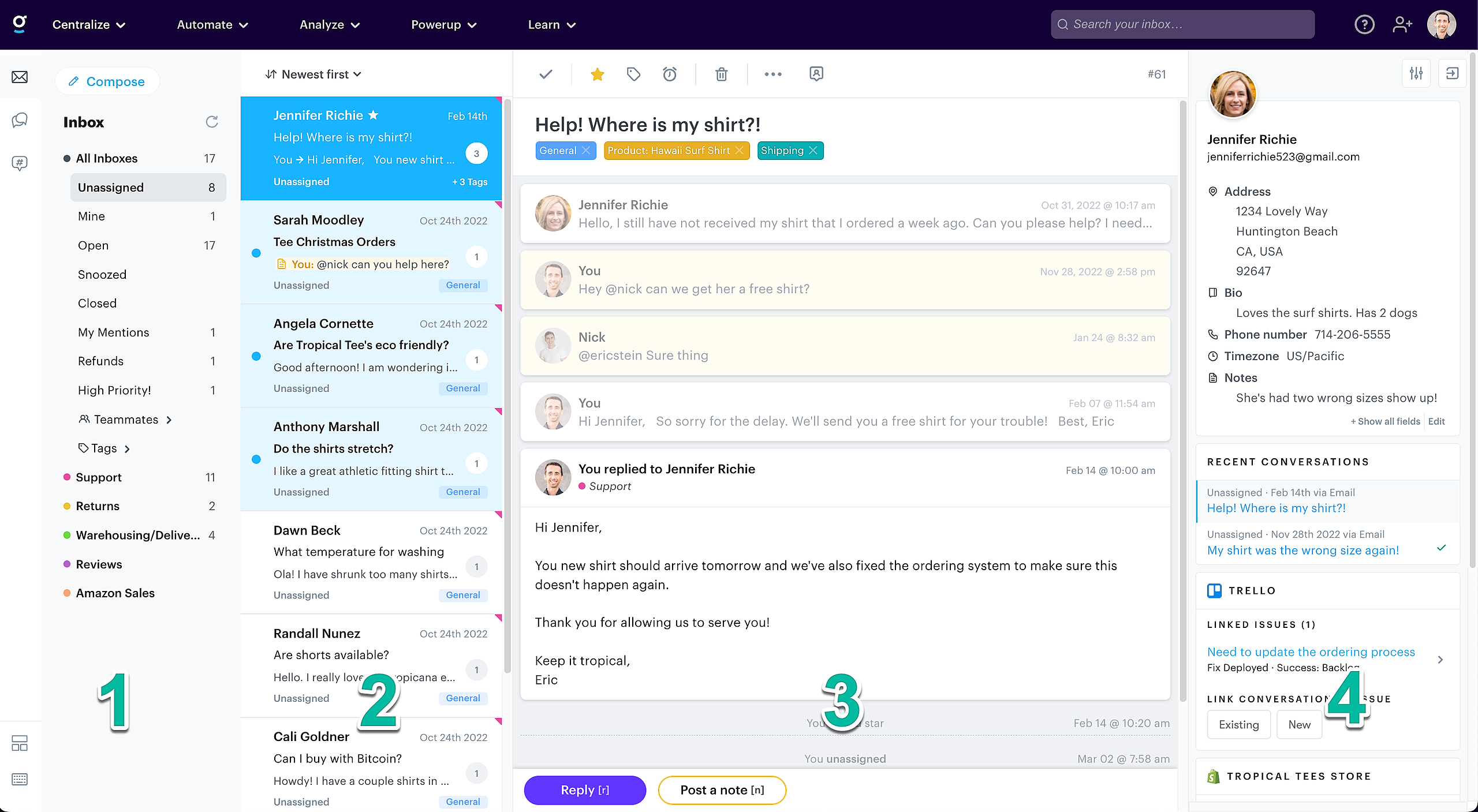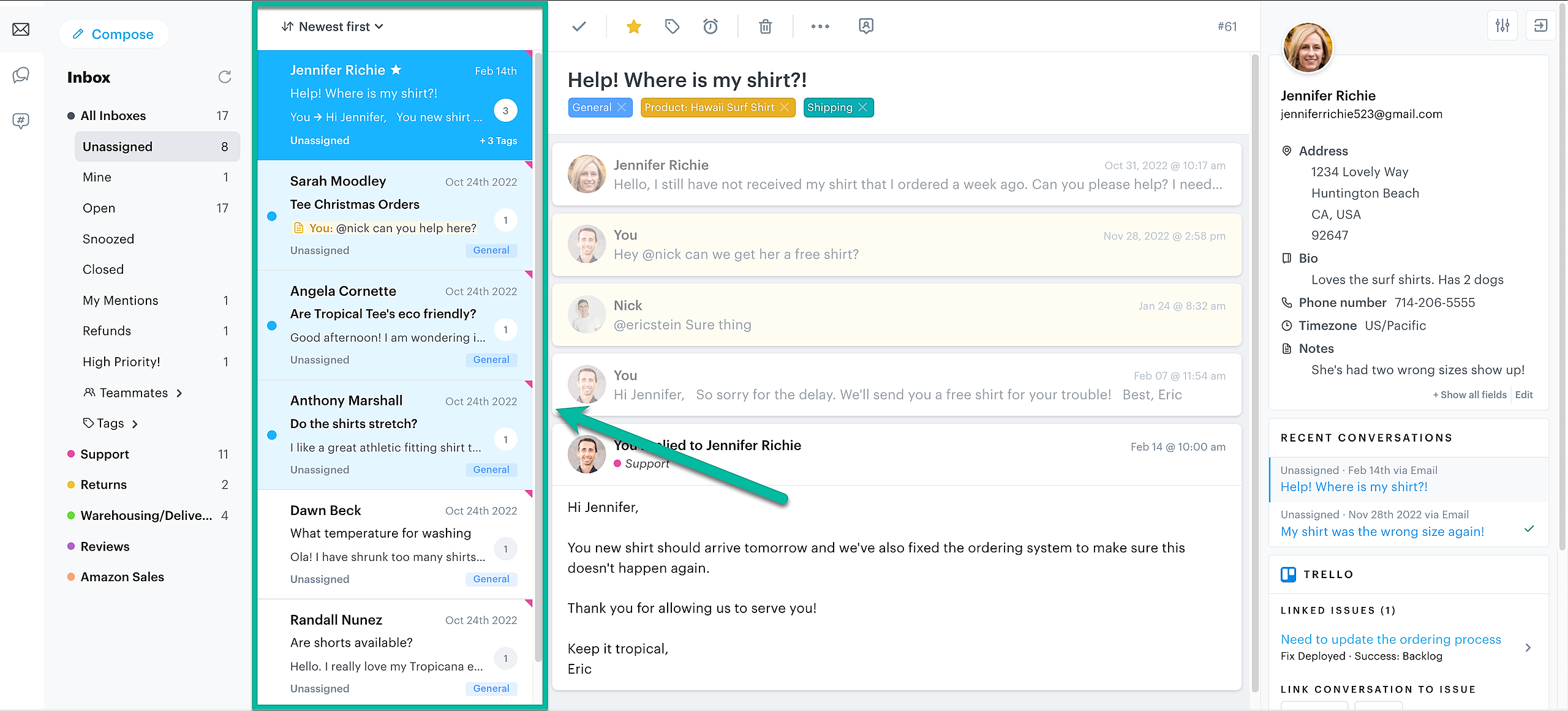The Groove Inbox looks and feels just like a modern email client and is broken down into four sections.
- Left navigation menu
- Conversation list
- Conversation page
- Right customer sidebar
1. Left Navigation
This menu contains links for your mailboxes, folders, teammates, and tags. You will use these links to navigate between your folders, view conversations assigned to other agents, and view conversations with a specific tag.
2. Conversation List
When you click one of the links in the left navigation, you will see the conversation list to the right populate with emails. Within the list you can see details about each email including a snippet of the last message, the time it was last updated, who it's assigned to, how many messages there are in the conversation, and the tags for each email. The top of the conversation list also includes the search form where you can search all of the emails in your account.
3. Conversation Page
The conversation page is where you can read the content of the email and take actions at the top of the page to assign, close, snooze, tag, move to another mailbox, mark as spam, and delete.
Here's the action bar in more detail:
- CLOSE - This marks the conversation as “resolved” and removes it from the inbox view unless it’s reopened. Do not use this for trashing irrelevant convo's or spam as it will skew the reporting data.
- STAR - Shows a star in the main inbox so you can keep an eye on it.
- TAG - Tags are identifiers that let you track the volume of certain conversations and easily find conversations in the search bar. E-commerce stores might have a tag for every product/service they offer. SaaS companies create Tags for every component of their software (Groove has tags for Inbox, Knowledge Base, Live Chat, Integrations, API, etc). All companies use tags for different customer complaints, returns/refunds, locations (if brink-and-motor), and more. Think of all the different conversations you have and create tags for them. This allows you to learn what’s important to your customers. **More on this below under Automations**
- SNOOZE - Temporarily closes a conversation until the day/time you choose in which it pops back into your inbox. Great for lower priority conversations or being used to follow up with customers.
- MERGE - If a customer emails twice about the same thing you can merge the conversations into one.
- MARK AS SPAM - Adds the email to a blacklist you can manage under settings.
- TRASH - Closes and removes from the inbox.
- CHANGE INBOX - If you have multiple inboxes, and someone emails the wrong one (maybe sales@yourcompany.com when they should have sent to support@yourcompany.com), you can easily move it to the appropriate one.
- FOLLOW - Gives you email notifications when anything happens with the conversation. Great for making sure a conversation or customer is handled properly, keeping an eye on VIPs, service recovery issues, or monitoring the results of a marketing campaign or product launch.
- ASSIGN - If people have specialties, or you want to make sure the right person takes ownership of a conversation, this feature is perfect.
The Reply Box is at the bottom of the page and you can either reply to the customer, forward to a third party, or leave an internal note for your teammates.
How to Toggle the Rich Text Editor Toolbar
If you don’t see the full toolbar in the rich text editor when replying to messages, click on the "A" button (or Format icon) to reveal additional formatting options. This button lets you toggle the toolbar on and off, so if you’ve hidden it by accident, this is how to bring it back:
The Reply Box at the bottom works just like email. You can change the subject or CC/BCC, and at the bottom you can change the formatting, add attachments, or use emojis. If you're using our Knowledge Base you'll see a KB search bar that lets you insert article links into replies.
PRO-TIP - Knowledge base articles are designed to thoughtfully answer common questions in article format so you don’t have to. The search bar lets you find relevant articles from your own knowledge base (FAQ page) and insert a link into your reply. More on the KB below.
Click Instant Replies to use a canned reply for common questions. You can create new ones on the fly or manage them under Settings → Instant Replies
PRO-TIP - we incorporate variables so predetermined info (like customer name, agent name, company info, etc) will be populated when you insert the reply, that way everyone can use them.
Notes let you leave relevant info about the customer/conversation right on the thread and also allow you to @mention teammates (which sends them an email notification) so you can collaborate together. Notes show up in YELLOW on the conversation thread and are never visible to the customer.
Pinning the Reply editor is helpful if you're needing to refer back to the customer message, while reading what you're typed up so far. This works well on larger screens, giving you the ability to see both the customer message and your writing at the same time. For smaller screens, unpinning the messages give you more scrolling space. In combination with pinning and unpinning the editor, something zooming in and out with your browser (Windows: CTRL + "+" or "-" | Mac: CMD + "+" or "-" ) can help to change your view depending on the detail that you'd like to see while using the reply editor.
4. Right Sidebar
The right sidebar contains all the details about the person who submitted the email. At the top you'll see personal details, below are other conversations from that person, and at the bottom you'll see any sidebar integrations you have installed for the account including the Custom Profile App, Stripe, MailChimp, and so on.











